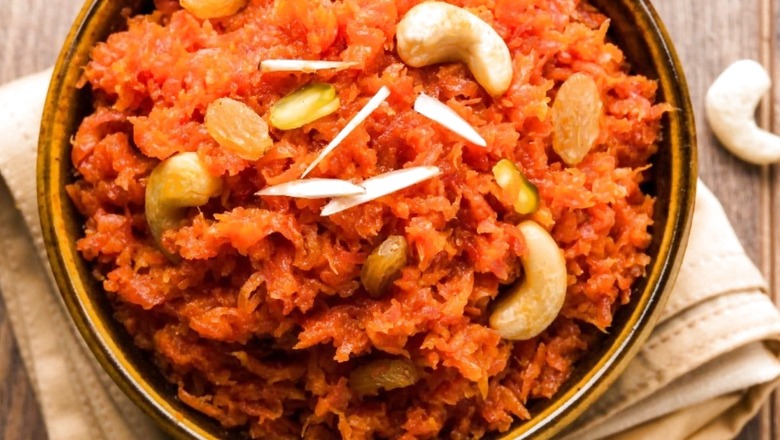
views
Winter in India brings along with it all sorts of root vegetables, tubers and leafy greens. Carrots, beetroot, radish, sweet potato, spinach, mustard greens, fenugreek leaves and green peas, and with these vegetables come winter dishes. Starting off with carrots – ‘Gajar Ka Halwa’. We all know ‘Gajar Ka Halwa’ but in the old streets of Lucknow at Rahmat Ali’s sweet shop, I ate the most delicious ‘Black Gajar Ka Halwa’. Deep purple in colour, these nearly black carrots are full of antioxidants and the kind of good properties found in blueberries, grapes and blackberries. This carrot grows only in the winter and adds an earthy taste to the halwa, which is made less sweet than the usual one, with no added khoya and ghee. Nothing keeps you warmer.
Speaking of ‘halwa’, if you can make ‘Gajar ka Halwa’, ‘Doodhi ka Halwa’, ‘Suji ka halwa’, why not ‘Ande ka Halwa’. After all, it is an old traditional recipe. ‘Halwa’ itself comes from the Arabic word ‘Hulw’, which means sweet, and seems to have arrived in India between the 13th to the mid-16th century during the Sultanate period, and may find its roots in the Ottoman Empire. Using eggs in desserts is quite common in any case, like in ‘malpuas’ and ‘watalappam’ both made during Eid and special occasions in north and south India. With lots of ghee, sugar, milk and patience, the ‘Ande Ka Halwa’ is warm as well as warming.
While both spinach and mustard greens are available in abundance during the winter, in Punjab, ‘Sarson ka Saag’ will always be made with mustard greens. No cheating with just spinach. Added to the mustard greens are four other vegetables, spinach, ‘bathua’, radish and fenugreek along with onion, tomatoes, green chillies, ginger and garlic and ‘makke ka atta’ for thickening. It results in a thick robust broth, which must compulsorily be doused in fresh white butter and eaten with smoky ‘makki di roti’.
Nothing defines a northern winter more than ‘Sarson Ka Saag’ and ‘Makki di Roti’, as the ‘Undiyo’ defines a Gujarati winter, especially the ‘Surti Undhiyu’. Made only during winter because Undhiyu uses vegetables that are only available during the season. Like green baby eggplants, purple yam, beans, raw banana and ‘muthias’ made from ‘methi’ leaves. It’s a bright green dry mixed vegetable dish with a distinct favour of coriander, chillies and besan.
In the bitter winter of Kashmir, the heart and hearth is warmed by a ‘Gushtaba’. The ‘Gushtaba’ is legendary and takes pride of place in any Kashmiri ‘Wazwan’. It is traditionally served as the last dish of the feast instead of dessert. ‘Gushtaba’ is minced mutton balls cooked in spices in a creamy gravy of curd and milk, spiced with fennel seeds, cloves, bay leaf and cardamom and cinnamon; extremely rich, heavy and perfect for the winter.
No winter morning in Agra is complete without a ‘Nihari’. It is a slow-cooked mutton or beef soup. The word ‘Nihar’ finds its etymology from the Arabic word ‘Nahar,’ which means ‘morning’. ‘Nihari’ in the days of the Nawabs and Mughal kings was slow cooked with spices all night, ready to be served after the morning prayers. If you walk through the narrow lanes of the walled city, there is ‘Nai Basti’ and, if my memory serves me right, “nai” does not mean “new” basti but the basti of ‘nais’ (barbers). In there is Mughal Nihari, which opens in the wee hours of the morning and big vessels get empty in just a few hours. Hot, spicy ‘nihari’ with sliced green chillies and ‘Khamiri Roti’ is a hearty winter need.
There is so much more food that drops in with the drop in temperature. There is ‘Shakarkandi ka chaat’ on the streets. Sweet and salty, boiled or fried sweet potatoes. Rajasthan’s ‘Gond Ka Ladoos’ are full of ghee, dry fruits and spices bound together with edible gum resin. Bengali ‘Nolen Gurer Sandesh’ is a traditional sweet made with freshly made ‘chenna’ (paneer) and ‘nolen gur’, a kind of date palm jaggery available only in winter. Soft, fudgey and melt in the mouth. Nutrition-packed ‘Panjiri’ is a mix of ghee, wheat flour and nuts. ‘Raab’ is a drink with shameless amounts ghee, a milk and flour.
Seems like everything we eat in winter in India is extremely biased towards ghee and richness. And why not, after all, we have a culture, which is as rich as ghee.
Kunal Vijayakar is a food writer based in Mumbai. He tweets @kunalvijayakar and can be followed on Instagram @kunalvijayakar. His YouTube channel is called Khaane Mein Kya Hai. The views expressed in this article are those of the author and do not represent the stand of this publication.
Read all the Latest Lifestyle News here


















Comments
0 comment